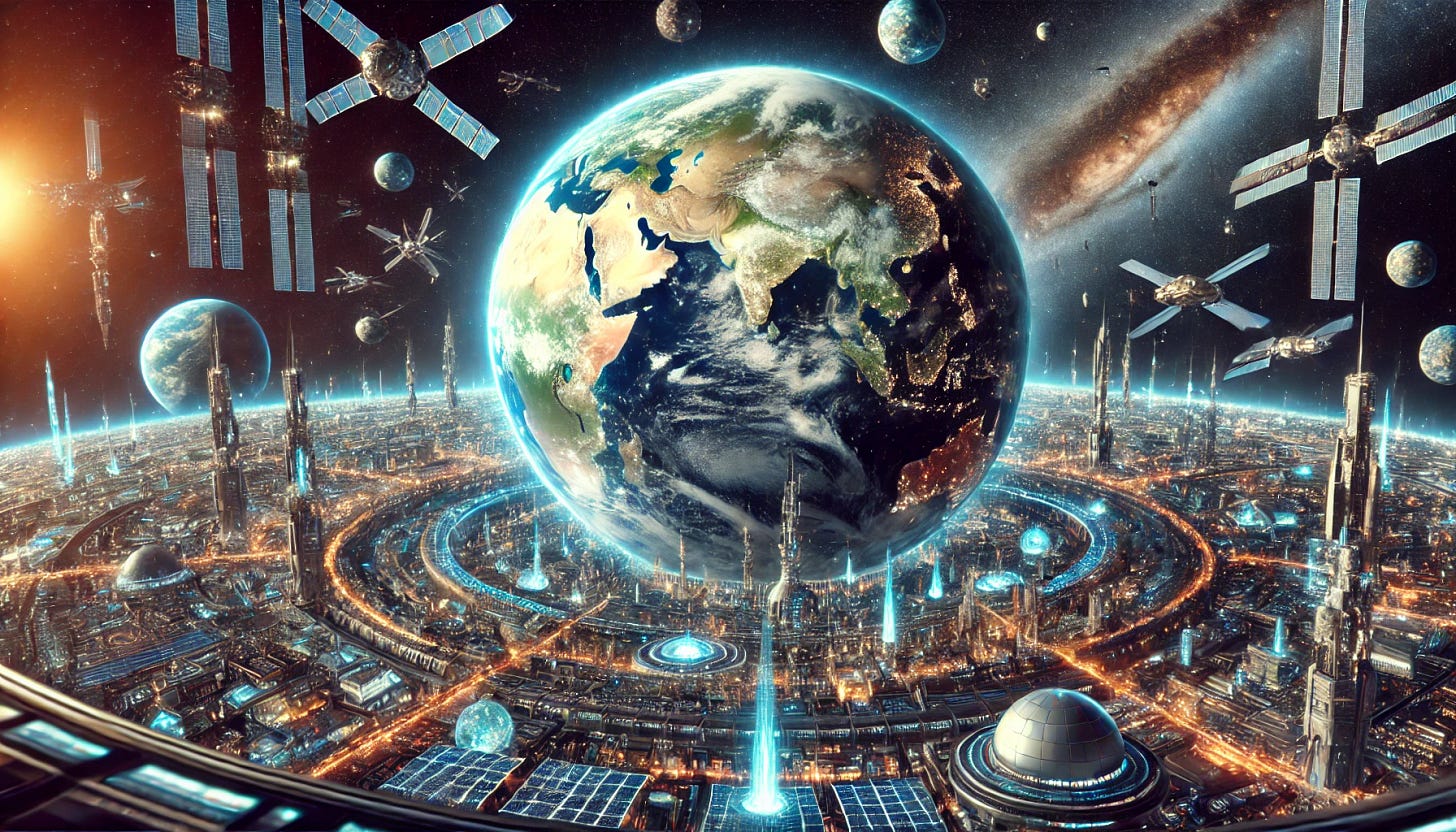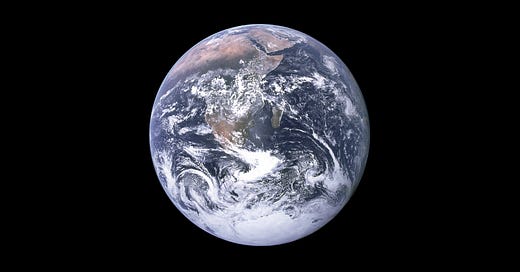It’s been a heck of a ride here in Cosmobiologist land of late. The Exoplanets in Our Backyard and XPANSE meetings were stellar, and there’s so much more going on. I’ll be writing about those events and some of the cool things happening in my own life here soon, but figured for today I’d share something different:
Here’s a piece about the need to “terraform” the Earth, not to make the Earth more Earth-like (that’s just silly) but to take control of our planet’s future as a global species and one that can enact change for good.
We Should Terraform the Earth
The concept of terraforming has been a mainstay in sci-fi and the science of space settlement for some time. It’s kind of remarkable not only to think about the potential of making other worlds more like our home, but also to realize that we have the tools and technology to start doing such a thing now. However, as some people over the past week have asked me a lot about the potential for terraforming Mars or even for seeding life intentionally on other worlds, I’ve kept coming back to one idea that I think is important for tomorrow:
We need to begin terraforming Earth. Not just making Earth more Earth-like (what would that even mean?!), but making Earth a world where we thrive in relationship with life and the planet and have an intentional control over the atmosphere and surface processes to ensure the maintenance of a world in which we can thrive.
Our planet is not just our home—it is the cradle of life as we know it. While it may be only one of many potentially inhabited worlds in the vast universe, it is, to our knowledge, the only place where life has flourished so abundantly. Earth is where humanity has grown, learned, and thrived. It is our sanctuary, our foundation, and the only true "homeworld" we have ever known.
And yet, Earth is indifferent to us. For centuries, humans have viewed themselves as exceptional, uniquely privileged in the grand cosmic narrative. However, as science has peeled back the layers of our self-importance, we’ve come to understand that we are not separate from Earth—we are a product of it. Humanity is an extension of the biosphere, a living testament to its evolutionary journey toward sentience and self-awareness. We are not masters of creation but participants in a planet-wide process, equipped with the tools to help our world understand itself and adapt to change.
Despite such humbling realizations, Earth remains our home.
Many of us have argued that humanity’s destiny lies among the stars: to explore, learn, and spread life beyond this world. Indeed, life itself is a force that compels growth and reproduction. Evolution has hardwired us to ensure the continuation of life, and this biological imperative extends beyond our mere survival. It might even extend to spreading life to other planets—a concept some (such as myself) view as the "reproduction" of living ecosystems on a planetary scale.
The “Planet B” Fallacy
The idea of needing a "Planet B" often arises in discussions of humanity's future. Proponents envision settling Mars or other planets, citing the possibility of Earth becoming uninhabitable due to environmental degradation or catastrophe. This vision of backup planets is ambitious but inherently flawed. If we possess the technology to terraform Mars—a lifeless, hostile world—why not use that same ingenuity to repair and rejuvenate Earth? The same sentiments came from many of us after watching Interstellar for the first time. It’s a great film but has one major flaw in its overall story: it presents a future where Earth’s resources are depleted and the planet is not longer suitable for humans to live, so they set out across space and time in a wormhole to terraform an entirely new alien world where life as we know it has never existed. But if they can do that, why not just terraform the Earth itself?
I’m totally in favor of sending life as we know it out into the cosmos to settle other worlds and to explore beyond what we’ve known. But I don’t see any reason given our current status that we should also have to leave the Earth behind.
Science fiction, like Interstellar, often romanticizes the idea of fleeing a dying Earth. Yet, such stories often overlook a simple truth: if we have the resources to make other planets livable, we have the means to heal our own for ourselves. Terraforming Earth is not a distant, speculative dream—it is an urgent, achievable mission. Especially given how much of an impact we’ve had already in making the Earth a little less livable in the near future for humans.
Practical Steps Toward Earth’s Renewal
Reclaiming and restoring Earth begins with initiatives we can implement today. Mangrove forests, for example, are a transformative tool in the fight against climate change and coastal erosion. These hardy ecosystems sequester immense amounts of carbon, stabilize coastlines, and create habitats teeming with biodiversity. Planting mangroves along vulnerable coastal areas would not only combat rising sea levels but also mitigate storm damage, enriching both human and ecological resilience.
Urban environments also hold untapped potential. We can transform derelict buildings, abandoned warehouses, and unused plots into urban gardens and green spaces. Imagine cities where vertical gardens thrive on once-crumbling walls, and edible landscapes provide sustenance for those facing food insecurity. Homelessness, an ever growing crisis in our current world, could be alleviated by integrating urban agriculture into city planning, creating agrarian hubs within metropolitan areas. These initiatives could turn blighted urban zones into oases of food production, sustainability, and beauty.
It was just announced that one outcome of COP 29 this past week is an agreement by “wealthier” nations to support $300 billion in climate aid to many of the nations with less resources who will also be impacted by climate change. While there are many arguments not only for and against such “payments”, there are also many arguments from some nations that far more should be given (the original ask was for $1.3 trillion). But I think this is an interesting sign of the global connectivity in addressing our impacts on the world’s climate (and human populations) moving forward. As we begin allocating resources for projects related to renewable energy, flood water mitigation, preparing shorelines for flooding, and more, it’s also likely that we’ll be seeing new technologies and ideas for large-scale alteration of our world to improve the future for all of us.
We’re sitting upon the verge of intentionally geoengineering on scales that some have only dreamed of.
While we are now moving more surface material on Earth each year through our mining and industrial activities than most geological processes, much of what we’ve done so far has been for the sake of resource extraction, development, and profit. But much as we’re just now tapping the potential of carbon sequestration, we could soon use geoengineering practices for large-scale atmospheric control.
I visited CarbFix in Iceland this past summer, and was pretty floored to think of the larger potential for storing carbon in human-produced rock that could be intentionally buried. But I’ve also been reading Project Hail Mary, which includes a consideration of what might happen if we need to intentionally increase the Earth’s greenhouse effect. There may be a near future where the sources and sinks—the give and take of carbon and the chemistry of our atmosphere—could be intentionally controlled on the continental scale in a way that gives humanity overall control of our atmospheric thermostat.
I also think often of our potential as a global species to finally make amends for the ways that we’ve destroyed habitat and negatively impacted other species of animals by creating massive scale animal preserves. A future terraformed Earth need not only be about making things comfortable for human life by itself, but also by supporting the complex web of life by ensuring habitats with rich biodiversity for others. Instead of continuing to burn down rain forests and grasslands across the glove, we have the potential for setting up massive reserves of forests and other biomes where living things could flourish without us (and maybe even with minimal incursion from us—could be cool to set up such a wilderness preserve and then let it go for decades or centuries on its own to see what evolution does).
The resources to implement such changes are certainly within our grasp. The barriers are not technological but attitudinal and systemic. Redirecting funds from destructive industries and wasteful practices toward initiatives that restore Earth’s ecosystems could yield immense benefits—not just for the planet but for humanity as a whole. By reclaiming land and reinvigorating life where it has been lost, we can reimagine our relationship with the Earth as one of stewardship rather than exploitation (even while still extracting and using the resources available to us).

A Call to Action
Terraforming Earth is not an abstract goal for a distant future. It is a tangible, urgent necessity. I suppose in the case of this writing, I’m speaking more to terraforming not as some project to do once and then be done (as we often see in scifi films and such), but rather as a means of maintaining control of the future geophysical state of the surface of the planet. More than that, it also means being intentional and thoughtful. Rather than just trying to be masters of the world, we could become the true stewards of the biosphere.
We have the tools, the knowledge, and the capacity to create a thriving, sustainable world. What we lack is the collective will. It’s time to shift our focus from escape plans and worst-case scenarios to proactive solutions that honor the planet we call home. We can explore space settlement and futures among the stars without having to imagine that we’ve grown so terrible that we’ve left the Earth unsuitable for human life in some dystopian future.
Certainly, given all that we’ve accomplished in coming to where we are now, we have the ingenuity and capability to work together to ensure that our planet continues as one that supports human life along with the rest of the biosphere.
Heck, one of my personal favorite answers to the Fermi Question is that maybe some advanced aliens are indeed watching us, but they’re waiting for us to show them some change or technology that would make it apparent that we are ready to meet: and maybe, just maybe, what they’re looking for is a species who has learned how to take intentional and supportive control of its world’s surface processes.




We are trying to impress on other people in or out of #ClimateCrisisClub on Twitter Spaces etc to contribute to this ideas forum on the topic. Supposed to be a positive in the increasing gloom of the climate slide.
I am a big fan of Earth terraforming, and there is no time, so can get on with, really big it up. I believe we have indigenous peoples with us too. Actually our #ClimateCrisisClub has been put to task on this aspect of stewardship by a Lakota Elder.